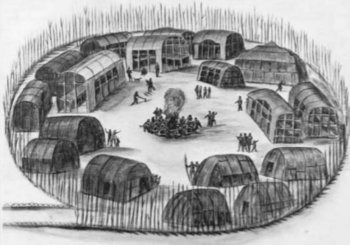Doeg people facts for kids

Watercolor by John White depicting an Algonquian village similar in appearance to villages in Tsenacommacah.
|
|
| Total population | |
|---|---|
| Extinct as a tribe | |
| Regions with significant populations | |
| Virginia and Maryland | |
| Languages | |
| Piscataway or Nanticoke (historical) | |
| Religion | |
| Native American religion | |
| Related ethnic groups | |
| Nanticoke, Pamunkey, Chickahominy |
The Doeg (also called Dogue) were a Native American tribe. They lived in the area that is now Virginia. The Doeg spoke an Algonquian language. This language was similar to the one spoken by the Nanticoke tribe. The Nanticoke lived on the Eastern Shore of Maryland. The Doeg tribe is known for a raid in July 1675. This event helped lead to a major uprising called Bacon's Rebellion.
Contents
Who Were the Doeg People?
The Doeg tribe was part of the larger coastal Algonquian language family. They likely spoke a language similar to Piscataway or Nanticoke.
Around 1557, about 50 years before the English founded Jamestown, the Doeg tribe split up. Some groups moved to different areas in Virginia. One group stayed in what is now King George County. Other groups moved to Caroline County and Prince William County.
Where the Doeg Lived
In 1608, Captain John Smith explored the upper Potomac River. He noted that the Doeg lived there, above Aquia Creek. Their main village, Tauxenent, was on an island. This island is now known as Mason Neck, Virginia.
The Doeg people were farmers and fishers. They grew corn and gathered fish. Other Doeg villages were located along creeks like Quantico Creek, Powells Creek, and Neabsco Creek. Nearby tribes included the Piscataway in Maryland. The Nacotchtank tribe lived in what is now Washington, DC.
Life on the Frontier
In the 1650s, English colonists started settling in the area called the Northern Neck. Some Doeg, Patawomeck, and Rappahannock people also moved into this region. They joined other local tribes in disagreements with the settlers. These disagreements were often about land and resources.
In July 1666, the colonists declared war on these tribes. By 1669, colonists had claimed much of the land west of the Potomac River. By 1670, most Doeg people had been pushed out of Virginia. They moved into Maryland. However, some Doeg remained near the Nanzatico tribe in Caroline County, Virginia.
The Doeg and Bacon's Rebellion
Tensions between the English colonists and the Doeg tribe continued to grow. In July 1675, a group of Doeg warriors crossed the Potomac River. They took hogs from a colonist named Thomas Mathew. They did this because Mathew had not paid them for goods they had traded.
Mathew and other colonists chased the Doeg into Maryland. They attacked a group of Doeg people. Sadly, they also killed some innocent Susquehannock people by mistake. In return, a Doeg war party attacked Mathew's farm. They killed his son and two of his workers.
A Virginia militia, led by Nathaniel Bacon, then went into Maryland. They attacked the Doeg and also surrounded the Susquehannock. This event helped start a larger conflict called "Bacon's Rebellion". This rebellion was a major uprising against Native Americans by the Virginia Colony.
After this conflict, the Doeg tribe seemed to join with the Nanzatico tribe. In 1692, the Nanzatico even paid to free some Doeg who were jailed. These Doeg had been jailed for killing livestock. The Doeg continued to live near Nanzatico in a place called "Doguetown." This area was near Milford in Caroline County. They were still there as late as 1720.
Legacy of the Doeg Tribe
The town of Dogue, Virginia is named after this tribe. Also, Dogue Creek, a stream that flows into the Potomac River in Fairfax County, Virginia, is named after the Doeg people.

